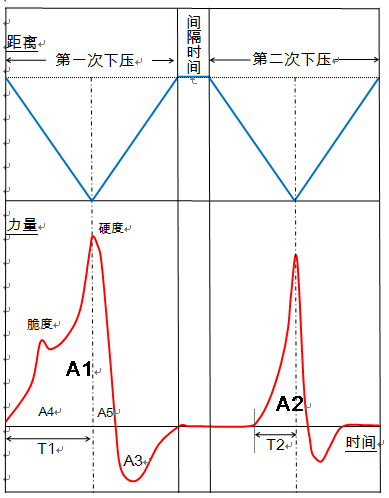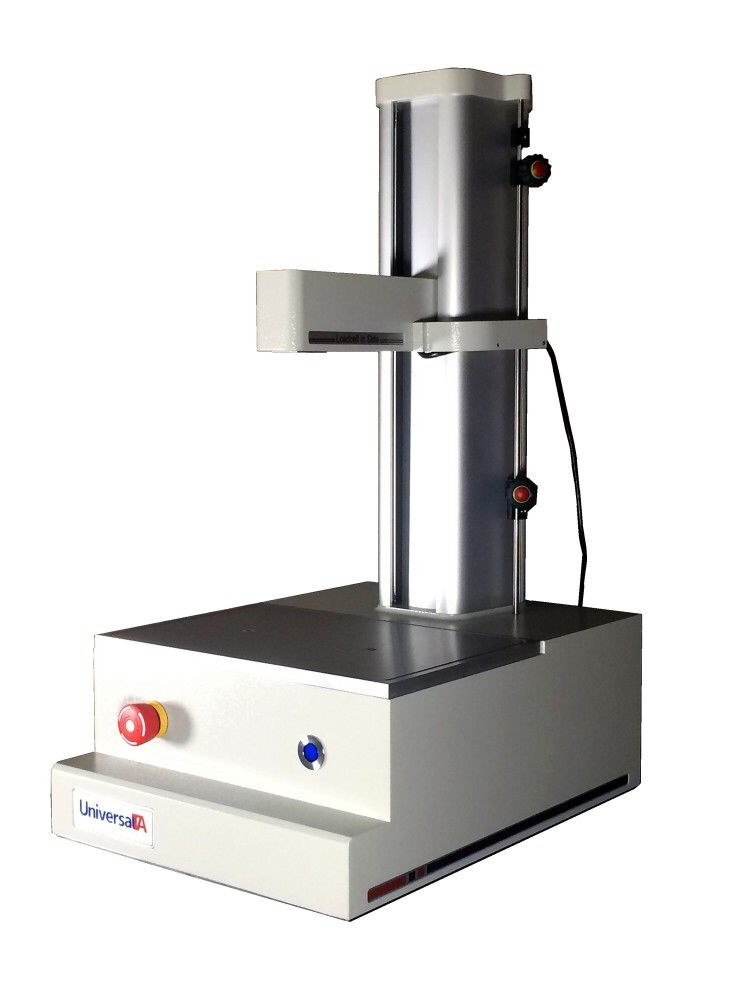1. What is the texture of food? For example: Get the texture parameters we need from the most typical full texture analysis (TPA) curve Typical TPA test curve Definition and calculation of texture parameters: Hardness: An indicator of the most direct response to mouthfeel. It directly affects Chewiness, Chewiness, and Cohesiveness in texture profile analysis. In the TPA diagram, the maximum force value in the section is first depressed. Fracturability: Unique to samples with a crisp outer shell (skin), most samples cannot measure this parameter. In the TPA plot, the smaller peak that appeared before the hardness. Adhesiveness: After the sample is subjected to pressure deformation, if the surface of the sample is sticky, it will produce a negative force. In the food field, it can be interpreted as a sticky mouthfeel. In the TPA plot, the area (A3) or maximum of the first negative peak. Springiness: The height at which food can recover between the end of the first bite and the beginning of the second bite. T2 / T1 in the TPA diagram Chewiness: Chewability is defined as the adhesive x elasticity. It can be interpreted as the energy required to chew solid food. It is difficult to measure accurately because chewing involves compression, shearing, puncture, comminution, tearing, cutting, etc., and is also related to oral conditions (saliva secretion, body temperature). This parameter is mainly used in the description of the solid, semi-solid mouthfeel. In the TPA diagram, the adhesiveness x elasticity = A2 / A1 x hardness x elasticity. Gumminess: Adhesion is defined as hardness x cohesion. One of the characteristics of semi-solid foods is low hardness and high cohesion. Therefore this indicator should be used to describe the taste of semi-solid foods. In the TPA chart, the adhesion = A2 / A1 x hardness. Cohesiveness: Cohesion is defined as the ratio of the first compression to the second compression positive force area. Tensile strength is a manifestation of cohesion. If a better sample is condensed, the display probe is also easier to keep clean. Cohesion is usually tested as a lesser parameter than brittleness, chewiness and adhesion. In the TPA chart, the cohesiveness = A2 / A1. Resilience: Resilience is a measure of how a sample recovers deformation, including both speed and strength. Defined as the ratio of the area before the deformation target to the area after the deformation target when the first depression is applied. Attention should be paid to the recovery of the sample during the measurement. Generally, a slower test speed is used to achieve sufficient time for the sample to recover. It also ensures the accuracy of this feature. In the TPA chart, the resilience = A5 / A4 4. The importance of texture analyzer in food texture analysis (1) Sensory analysis of food texture is susceptible to human factors such as personal preference, personal physiological state, personal sensory threshold, etc. The results are subjective, resulting in significant impact on the authenticity, repeatability and stability of the data results. The texture analyzer is not affected by human factors and has objectivity, which greatly improves the authenticity, reliability and repeatability of the data. 5 Classification and function of texture analyzer (1) Multifunctional texture analyzer The multi-functional texture analyzer can measure the hardness, brittleness, adhesion, relaxation, softness, breaking strength, adhesiveness, recovery, elasticity and friction coefficient of fruits, vegetables, baked goods, meat products, dairy products, snack foods, etc. , yield stress, ductility, gel strength, maturity and many other indicators. In addition, during the experiment, the test distance, test speed, test mode, etc. are highly adjustable, and more than 400 sets of probes are available, which can obtain multiple indicators of multiple products, and the function is very powerful. It is suitable for physical research and teaching applications in food research institutes and universities, food quality control, formulation research, production process research, quality control and product development. (2) Single-function texture analyzer Compared with the multi-function texture analyzer, the single-function texture analyzer has the test distance, the test speed, the test mode is fixed, the specificity is strong, the test result is strong (only to obtain a specific texture parameter), and the operation is simple ( No need for complicated training, one-button operation, the result is automatically displayed in real time) and so on. The machine is portable and easy to operate outdoors and on the move. Single-function texture analyzers are highly targeted and often have many aliases, such as gel strength meters for measuring gel strength, meat tenderizers for testing tenderness, and for testing fish gills. Flexible elastic testers, etc., so the single-function texture analyzer is very suitable for enterprise quality control and product development, as well as teaching demonstrations in schools.
The texture of food refers to the nature of the food perceived by the eye, the membrane in the mouth and the muscles, including the thickness, smoothness, graininess, etc. The ISO (International Organization for Standardization) stipulated food texture refers to the use of "mechanical, Tactile and possible words also include a comprehensive sense of the rheological properties of food that can be perceived by visual and auditory methods.
2. The importance of food texture
The texture of the product affects the characteristics of the product in five aspects: first, the texture affects the quality of the taste of the food; second, the texture affects the processing of the product, such as the product with too small viscosity is difficult to deposit in the bread sandwich On the surface of the bread, as we develop fat-replacement low-fat products, build a suitable viscosity to obtain a reasonable mouthfeel, but if the product is too sticky, it may be difficult to sterilize through a plate heat exchanger; third, texture Affect the flavor characteristics of the product. Some hydrophilic colloids, carbohydrates, and starch affect the release of flavor components by combining with flavor components. Many studies now focus on how to use this combination to match the flavor release of low-fat foods with high-fat foods, ultimately achieving a similar mouthfeel. Fourth, texture is related to product stability. In a food system, if phase separation occurs, the texture must be poor, and the quality of the taste at the time of eating is also poor. Fifth, the texture also affects the color and appearance of the product. Although it is an indirect effect, it does affect the color, smoothness and gloss of the product.
3. How to analyze the texture of food?
Sensory analysis Humans can be divided into seven steps of sensory experience when eating. The first step is the surface texture, which includes the first feel of the food reaching the mouth and the overall texture appearance of the product. The next two steps are partial compression and the first bite. This is a mechanical process that, together, determines the elasticity, hardness and cohesion of the product. The first chew revealed many of the characteristics of the first bite including the viscosity in the mouth and the density of the food. The chewing process reveals the moisture adsorption of the sample and the density of the food at this stage, and the flavor release of the food can be assessed. When chewing continues until swallowing, all the humidity and enjoyment of the product becomes very important. The sixth stage of texture evaluation is the rate of melting, which is the degree of melting of the food in the mouth. The seventh stage is the retrospective phase, which is to review the product's feeling in the mouth after swallowing.
Instrumental Analysis Instruments analyze the texture of food based on the rheological science of food, ie the measurement of the deformation and flow characteristics of the material. The instrument analysis mainly simulates the movement of the oral cavity, compresses and deforms the sample, and can analyze the texture of the food. It mainly includes physical property analyzers such as food texture analyzers, viscometers, and fruit and vegetable hardness testers. Among them, the texture analyzer is the most widely used in the food field, and has the most measurement indexes, including hardness, viscosity, elasticity, recovery, chewiness, brittleness, and cohesiveness. Although the texture analyzer cannot fully simulate the oral motion of a person, the obtained texture parameters or indicators can well reflect the taste or texture of the food. 
(2) The texture analyzer can describe the texture of the food in a quantitative way, quantify the texture characteristics of the food, and thus provide the principle and method for discovering the perception of sensory stimulation in order to reveal the causes of various sensory stimuli. The conditions.
(3) Through the texture analyzer to study the influence of food raw material formula on the texture of the food, it can be predicted how the addition or addition of the food raw material will affect the texture of the food, and it has a lot of help for the addition of raw materials and product development.
(4) Studying the effect of food processing technology on the texture of food through a texture analyzer, predicting what effect it will have on the texture of the food after using a certain processing technique, which can be used to help adjust the food production process.
(5) Determine the texture of different batches of products through a texture analyzer, and implement automatic quality control of food production raw materials and final products.
(6) Texture analysis is used to analyze the quality of products sold on the market or products with good reputation, and provide data support and theoretical basis for us to develop new products or improve old products. 


![]() Related accessories: The importance of texture analyzers in food research and processing.pdf
Related accessories: The importance of texture analyzers in food research and processing.pdf